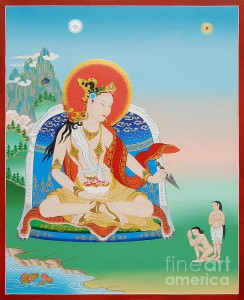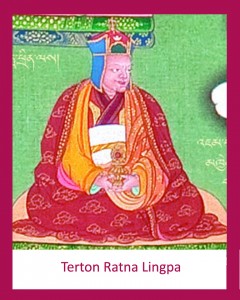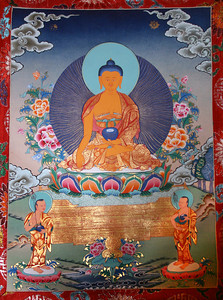The following is respectfully quoted from “Mother of Knowledge” translated by Tarthang Tulku and J. Wilhelms:
Yeshe Tsogyal recounts entering the Mandala of the Dakinis:
“Eight cemeteries formed a ring, rimmed by walls of beautiful lotuses. Predatory flesh-eating birds and wild blood-drinking animals wandered about, and demons and demonesses, roaming in great numbers, stood out vividly against the landscape.
“Although the beings there did not attack me or threaten me, neither did they make friendly overtures. As I advanced upwards, I passed along a path that circled in a zigzag fashion three times, and ended at a door. Within were many dākinīs whose external appearance was that of women but they were of many different colors. They were carrying offerings to present to the principal dākinī.
“Some of the dākinīs had cut their bodies into small pieces with razor-sharp knives and prepared offerings of their own flesh; others were giving their streaming blood. Some were giving their eyes, some their noses. Some were giving their tongues, still others, their ears. Some were giving their hearts, others were giving their viscera. Some were giving their outer muscles, some their inner organs. Still others were giving their bones and marrow.
“Some were giving their life energy, others their breath, and still others, their heads. Some had cut off their limbs, and so on. They had cut up their own bodies and had prepared offerings of them for the principal dākinī, who appeared Yab-Yum before them. The offerings were then blessed as signs of their faith.
“Then I asked the dākinīs: ‘Why do you suffer in this way? To what purpose? If one lives in accordance with the Dharma until death, is that not sufficient?’ And they answered me:
‘Dear woman of irresolute mind!
The compassion of a great teacher who has all the qualifications may only be available briefly.
If you do not offer whatever he wishes when he looks upon you,
later nothing you do may lead to fulfillment.
If you procrastinate, obstacles will multiply.
‘Your insight and certainty may last only a moment;
natural and spontaneous faith may not stay long.
If you do not make the offering when Pristine Awareness arises,
later nothing you do may lead to fulfillment.
If you procrastinate, obstacles will multiply.
‘Now, at least you have a human body–you may not have it long.
The chance to practice Dharma seldom arises;
if you do not make offerings when you meet a qualified teacher–
if you procrastinate–obstacles will multiply.
‘The teacher may only be here briefly;
only now can you be certain to enter the door of the secret teachings.
If you do not offer yourself
when you have access to the highest Dharma–
if you procrastinate–obstacles will multiply.’
“Thus they spoke, and I felt ashamed. Then, as each dākinī presented her offering, the Vajra Yoginī appeared before her, snapping her fingers. Instantly each supplicant was healed and became as before. After requesting a regular Dharma practice from the principle dākinī, each one returned to her own meditation place.”





